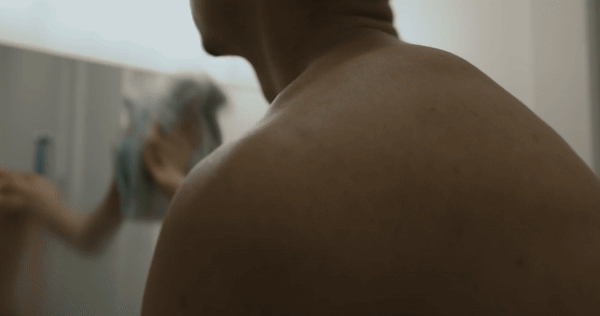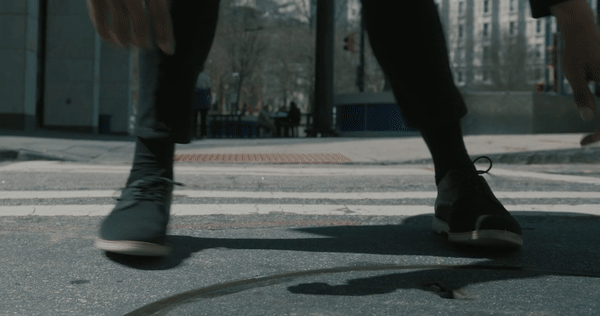Building for the senses in tech: transcending the stage
This article is part of our special series on Flesh
What movements and bodily experiences will emerging technologies need to capture and represent to evoke the visceral and transcendent qualities of dance? An interview with dancer, choreographer and director Claudia Schreier, writer and director Adam Barish, and ReD partner Ian Dull.
Ian Dull: With new augmented, virtual and mixed reality technologies on the way, we’re interested in understanding how to make these technologies – and the digital worlds they enable – more human and meaningful. In the past, we’ve studied people who use their bodies and their senses in extraordinary ways to discover what they notice and feel in order to understand what isn’t well-captured or -communicated in technology today and can be enhanced in the future. To that end, I would be really curious to understand the sensations that you experience as a professional dancer and choreographer. What does it feel like to be dancing at such a high level?
Claudia Schreier: Before describing what it feels like to choreograph, I think it’s useful to share the distinct, yet overlapping perspectives that inform my own. There’s the experience of the dancer, the audience, and the choreographer. As a dance maker, my responsibility is to cater to the “needs” of each vantage point, with the goal of providing an experience that is viscerally satisfying to all three. A dancer performing at their peak will sometimes experience what can best be compared to a runner’s high – a euphoric surge in endorphins borne out of pushing the body and mind seemingly past its limits, only to reach a level of achievement that is its own reward. For a dancer, that transformative exertion is not always measured in physical power – in fact, some of a dancer’s most treasured memories onstage are feats of the mind, even if the performance did not appear particularly physically taxing. Those experiences can feel spiritual. Flipping the perspective, audiences can feel elation from witnessing a wide range of performances – from acrobatic, gravity-defying acts to subtle, yet profound movements – if the design of the dance is purposefully crafted to cater to both sides of the proscenium. This is where what the choreographer feels is essential.
Ian: Could you talk a little bit about what that is like in practice – how do you build a sense of those confines and how do you transcend them?
Claudia: In a way, it comes back to the analogy of the runner’s high – it’s about finding a sense of unbridled freedom and fulfillment through a lifetime of rigorous training, focus, and sacrifice. The physical training required is akin to that of many high-level competitive sports – there’s a reason why dancers are sometimes called “athletes of God”, a quote attributed to Albert Einstein. The ritual of daily practice for elite musicians is another analogy – dancers will take daily morning class, conditioning their bodies with a series of exercises based in a codified technique and set to music that prepares them for the ever-changing demands of a rehearsal and performance day. But from there, it’s about taking the box, honouring it, and then busting out of it.
Ian: Could you speak to some of the cues and metaphors or ways you wind up communicating around what you’re trying to achieve in your choreography?
Claudia: Finding balance between communicating verbally and physically is at the core of everything I do. In essence, choreography is about taking an existing language and morphing it to match one’s imagination. Many dance techniques have a codified vocabulary that can serve as a baseline or shorthand for certain steps, such as the ballet phrases tendu croise devant or rond de jambe en l’air en dehors. If I envision movement that requires modification to these steps to achieve the desired result, I must find the right combination of verbal and physical cues. It’s like asking someone who speaks English to say the word recording as re-cord-ING – the pronunciation may not be intuitive, but it yields an interesting and unexpected way of approaching the word. All the building blocks are still there, but through the adjustment of timing and timbre, they can be reconfigured.
Ian: Adam, I’m curious when you think about how you capture this intricate language visually and show it to an audience, what are some of the things you’re thinking through there to play up the viscerality or to help them see the intention? What do you pay attention to in terms of mise-en-scène?
Adam: Dance is particularly well-suited to live performance because the sweat on a dancer’s brow is evidence of dance’s defining characteristics: artistry and athleticism. The best dancers are world-class bodies and world-class musicians. It’s not impossible, but it’s much more challenging to film a dance that evokes audience reactions that are similarly impactful to those engendered in a live setting. If you go back and watch a Gene Kelly or Ginger Rogers film, you’ll see a lot of wide shots; Fred Astaire’s contract mandated that every shot of his dancing was full-body. That’s because dance operates on some of the same principles as magic – the audience needs to see magicians perform their trick right in front of them, nothing hidden, all limbs right where they can see them so that any sleight of hand is earned, not cheated. Part of what makes dance amazing is that their bodies really did that, all of that, right before your eyes. But, in exclusivity, this scope, this wideness, runs counter to so much of what the medium of film does well. Watching dance in a theatre or on the street means seeing everything and choosing where to direct your gaze. But “cinema”, to quote Martin Scorsese, “is a matter of what’s in the frame and what’s out”. I believe depth and intimacy are the best lenses to capture the artistry of dance on film, while breadth and scale are the best lenses to capture the athleticism; the former inspires emotion, the latter inspires awe.
Ian: When you’re trying to capture something on film. What are the things that feel magical to see and that you want to capture?
Adam: When the switch flips and the dancer goes from a human being who breathes and sweats like you and me to a superhuman. That transition is the magic. And that’s what you don’t necessarily see live, right? Live you might only see the superhuman. A camera can reveal both.
Ian: When for you does it become superhuman? What is the threshold?
Adam: I love the question. It’s probably unanswerable, but I will do my best. There are two types of moments that strike me as superhuman. One is definitely a feat of incredible athleticism, strength, agility, when it inspires a sense of “I can’t believe that they were able to do that, that they were able to summon whatever was required of their body.” The other moment comes from the choreographer, when they conjure and execute something that takes the dancer in a direction I never could have anticipated.
Ian: Thinking about the explosion of new virtual and intelligent technologies, how do you think dance will translate? If you imagine being in a virtual world, people can jump up and down and bend over backwards and do a thousand pirouettes in a circle. What kinds of things do you think will stand out or be necessary to express that kind of superhumanness?
Adam: If we are trying to simulate some kind of facsimile of real life, I think we will fail at making the virtual consistently worthwhile – it will be like empty calories. Let’s say I’m wearing a headset and I’m transported onto the stage with Misty Copeland, and she puts her hand on my shoulder and I feel that, I don’t think that will have the impact we might desire because then you’re trying to literalise that reality. I believe that there is more staying power for a virtual experience like, “OK, I’m wearing a headset. Misty Copeland and I are dancing on stage. But instead of touch, what I’m feeling is the music. The music is vibrating down my spine.” You’re not exclusively trying to literalise the physical sensation of what you’re seeing – instead, you’re trying to create a superhuman sensation, distinct from real life.
Claudia: I agree that you can’t genuinely replicate the experience. You can’t replicate decades of training, or the focus and the sacrifice and the time. Sure, you can feel a hand on your shoulder, but as Adam says, you’re not going to feel it in every fibre of your being and summon decades of skill development that led you to that moment. A question I would ask in return is, how much do the creators of VR want to mimic the experience of being in another human’s body? When I’ve used VR in the past, I’ve experienced a full field of vision and seeing everything that the eyes can technically capture, all at once. But that expansiveness is at the expense of depicting what the human eye can truly process at any given moment, including eyeball movement, depth of field, and how much the focus can change in any given second. It’s from the perspective of a camera, not a human brain. If you’re a dancer on stage, your eyes might be up close to the back of your hand, and then they might shift to the vast darkness of the audience, and then they may track a dancer or two moving in front of you – all of which might happen in a split second. So, the lens is capturing the world from a specific perspective, but it is not yet advanced enough to more closely mimic a a more embodied experience that pushes beyond the visual frame.
“If we are trying to simulate some kind of facsimile of real life, I think we will fail at making the virtual consistently worthwhile – it will be like empty calories.”
Ian: As a choreographer and as someone with a deep appreciation for dance, what do you get excited about being able to do that you can’t do today?
Claudia: There’s no true substitution for being present in the room with dancers during a rehearsal process, but after becoming experienced with rehearsing through online video calls during the pandemic, I can absolutely imagine a world in which it becomes an immense cost- and time-saving asset to be able to virtually insert myself into a studio and interact with holographic dancers in real time. That’s where eye movement doesn’t matter, because I’m not trying to replicate what it feels like to be inside another person’s body. I only need to get as close as I possibly can to the experience of being physically present in a room surrounded by moving bodies.There are a lot of exciting potential avenues for the crossover of dance, choreography, and virtual reality that actually have nothing to do with the performance itself. It can also be about supporting the creatives, the dancers, and the health of the dance ecosystem as a whole.
Adam: If you’re consuming art, you should be allowed to remain in the position of a consumer, someone who absorbs the art as fully as possible without becoming it. Otherwise you break the spell that performance so critically requires. Instead, can we explore more synesthetic ideas that connect, say, colour and visual depth with all manner of things, like the taste of sweat, or tactile sensations that make music actually feel like it’s happening in the real world, as if my headphones (and supporting tech) could transmit less of a non-diegetic soundtrack for my life than a diegetic musical number from the story of me? Sign me up for that metaverse.
This interview is part of our special series on Flesh



